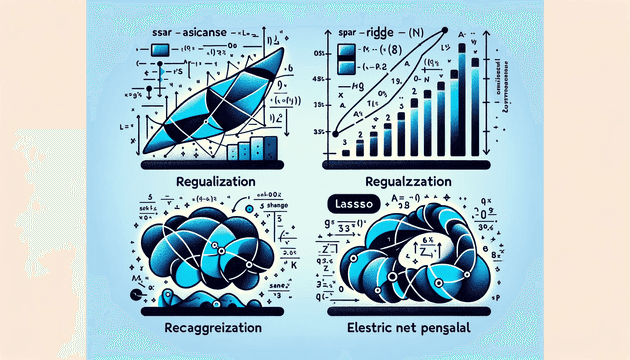In the field of machine learning and statistical modeling, regularization is a crucial technique used to prevent overfitting and improve the generalization of models. This blog post will delve into three popular regularization methods: Lasso, Ridge, and Elastic Net Regression, elucidating how they function and when to use them.
What is Regularization?
Regularization is a technique used to reduce overfitting in machine learning models. Overfitting occurs when a model learns not only the underlying pattern in the training data but also the noise. This leads to poor performance on unseen data. Regularization addresses this issue by adding a penalty term to the loss function used to train the model. This penalty term constrains the model, making it simpler and less prone to overfitting.
Ridge Regression (L2 Regularization)
Ridge Regression, also known as L2 regularization, adds a penalty equal to the square of the magnitude of the coefficients. The regularization term is added to the loss function, and it includes a tuning parameter, λ (lambda), which determines the strength of the penalty. A higher value of λ shrinks the coefficients more, leading to a simpler model.
Key Features of Ridge Regression:
- It tends to shrink the coefficients of the model uniformly.
- Suitable for scenarios where many features have a small or moderate effect on the output variable.
- Ridge regression does not perform variable selection - it includes all features in the final model.
Lasso Regression (L1 Regularization)
Lasso Regression, short for Least Absolute Shrinkage and Selection Operator, involves L1 regularization. It adds a penalty equal to the absolute value of the magnitude of coefficients. Like Ridge, it also has a tuning parameter, λ, which controls the strength of the penalty.
Key Features of Lasso Regression:
- Lasso can shrink the coefficients of less important features to exactly zero, thus performing variable selection.
- Useful when we have a large number of features, and we suspect that many of them might be irrelevant or redundant.
- Can lead to sparse models where only a subset of the features contributes to the prediction.
Elastic Net Regression
Elastic Net Regression is a hybrid approach that combines both L1 and L2 regularization. It adds both penalties to the loss function. Elastic Net is particularly useful when there are multiple correlated features. It includes two parameters: λ (like in Lasso and Ridge) and α, which balances the weight given to L1 and L2 regularization.
Key Features of Elastic Net Regression:
- Balances the properties of both Lasso and Ridge.
- Works well when several features are correlated.
- Elastic Net can be tuned to behave like Lasso or Ridge regression by adjusting the α parameter.
Choosing the Right Regularization Method
The choice between Lasso, Ridge, and Elastic Net depends on the data and the problem at hand:
- Ridge is a good default when there is not much feature selection needed or if the features are expected to have roughly equal importance.
- Lasso is preferred if feature selection is essential, and there is a need to identify the most significant variables.
- Elastic Net is ideal when there are multiple correlated features, or a balance between feature selection and uniform coefficient reduction is required.
Conclusion
Regularization is a powerful tool in machine learning, helping to enhance the performance and interpretability of models. Lasso, Ridge, and Elastic Net are versatile methods that can be applied to various regression problems. Understanding their differences and applications is key to building robust and accurate predictive models.
